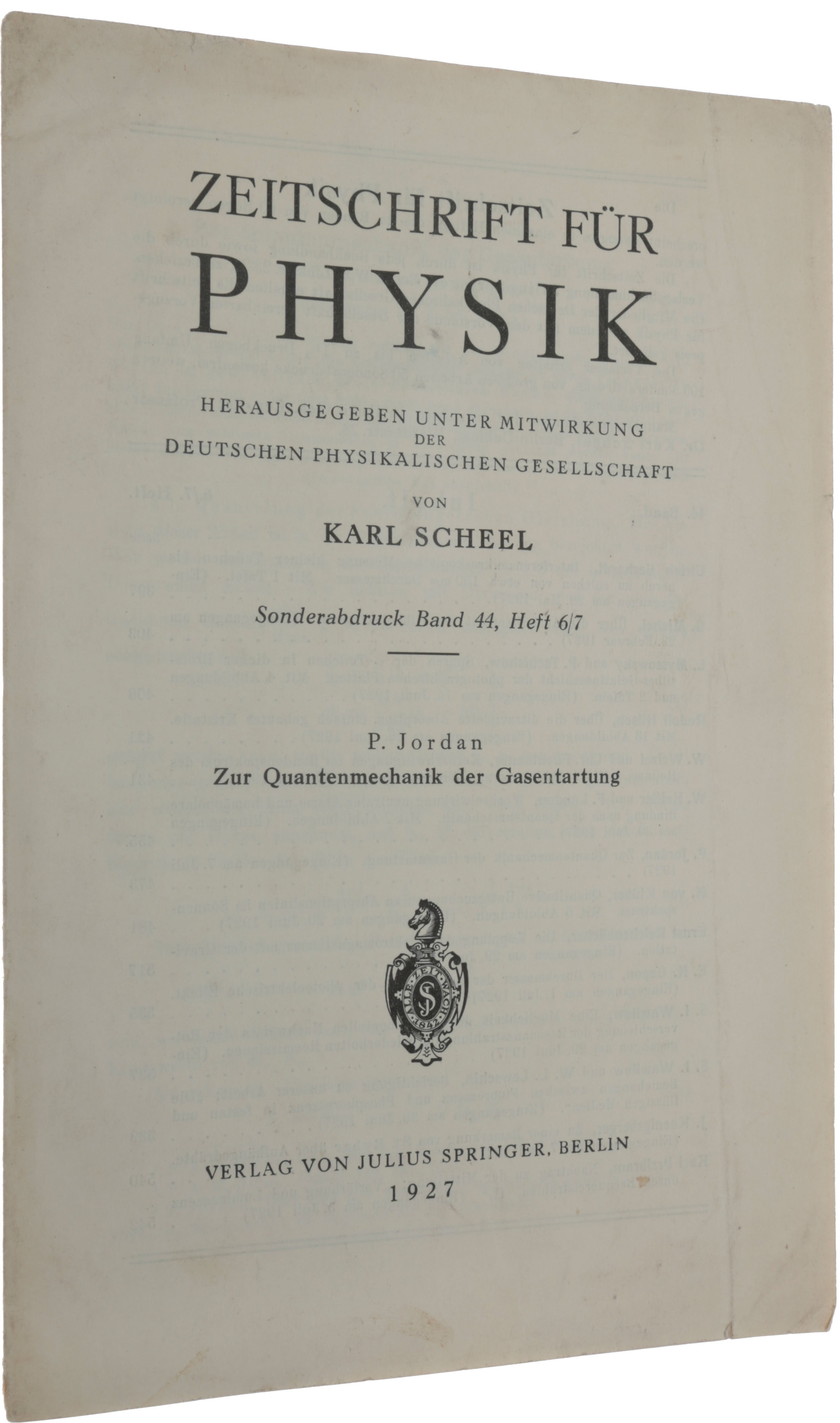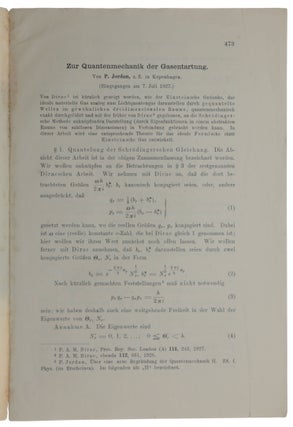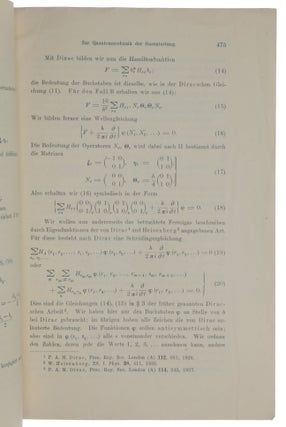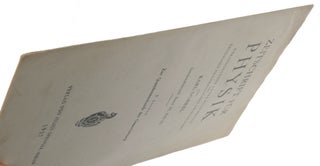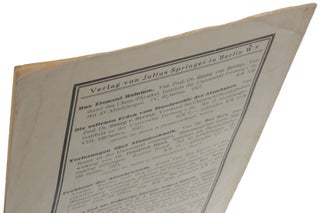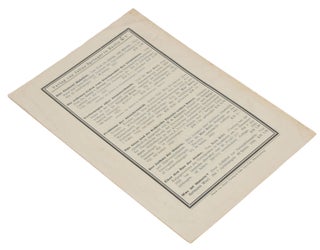Zur Quantenmechanik der Gasentartung. Offprint from: Zeitschrift für Physik, Band 44, Heft 6/7.
Berlin: Springer, 1927. First edition, extremely rare offprint, of this important paper, in which Jordan introduces his approach to quantum field theory, independent of Dirac’s, and also gives his formulation of Fermi-Dirac statistics, which he had developed earlier than both Fermi and Dirac. “Pascual Jordan is the unsung hero among the creators of quantum mechanics. Major portions of the two papers he co-authored with Born and Heisenberg that elaborated matrix mechanics, following Heisenberg’s initial insight, were Jordan’s contribution. Similarly, he was responsible for laying the foundations of quantum field theory” (Schweber, pp. 5-6). “Before the end of the year [1925] Jordan had submitted a single author paper. This papercontained what is nowadays known as the Fermi-Dirac statistics; however it encountered an extremely unfortunate fate after its submission because it landed on the bottom of one of Max Born’s (in his role as the editor of the Zeitschrift für Physik) suitcases on the eve of an extended lecture tour to the US, where it remained for about half a year. When Born discovered this mishap, the papers of Dirac and Fermi were already in the process of being published. This paper by Jordan was never published, but he further developed its contents and this extended piece of work, Zur Quantenmechanik der Gasentartung [‘On the quantum mechanics of gas degeneracy’], was published by Jordan in 1927” (Mactutor). “Jordan was the earliest and most ambitious visionary of the quantum field theory program: long before this became commonly accepted in the second half of the twentieth century, he saw in quantum field theory a unified basis for all of modern physics” (Lehner, p. 272). The present paper “already defines Jordan‘s program: a unified quantum field theory for matter and radiation. Particles and waves are only two different aspects of the same underlying quantum field both in the case of light and in the case of matter” (ibid., pp. 280-281). No copies in auction records. Not on OCLC. “The year 1925 was a bright start for the 22-year-old Jordan. After the submission of the joint work with Max Born on Matrix Mechanics, in which the p-q commutation relation appeared for the first time, there came the famous ‘Dreimännerarbeit’ with Born and Heisenberg in November of the same year, only to conclude the year’s harvest with a paper by him alone on the ‘Pauli statistics’. Jordan’s manuscript contained what is nowadays known as the Fermi-Dirac statistics; however it encountered an extremely unfortunate fate after its submission … In the words of Max Born a quarter of a century later: ‘I hate Jordan’s politics, but I can never undo what I did to him … When I returned to Germany half a year later I found the paper on the bottom of my suitcase. It contained what one calls nowadays the Fermi-Dirac statistics. In the meantime it was independently discovered by Enrico Fermi and Paul Dirac. But Jordan was the first’” (Schroer, pp. 2-3). “The year 1927 was the most fruitful in Jordan’s career … The second paper submitted in July 1927 [offered here] was inspired by Dirac’s field-theoretic transcription of the quantum mechanical multi-particle configuration space for Schrödinger’s formalism (‘high dimensional abstract space’) to the quantization of Schrödinger waves in ordinary space. Jordan sets out to do something analog[ous] for ‘Fermi’s instead of Einstein’s gas’. He develops what he refers to as the ‘Pauli-statistics’ (probably using material from his ill-fated 1925 manuscript which ended in Born’s suitcase) and uses the quantized spacetime field formulation to compute the density fluctuations in a Fermi gas” (ibid., p. 4). “As he claimed in [the present paper, p. 480] and in a letter to Schrödinger, his occupation with the quantum theory of the ideal gas had suggested this further application of the theory of quantized waves. Jordan writes in the letter: ‘Then your hydrogen paper [i.e., ‘Quantisierung als Eigenwertproblem (Zweite Mitteilung)’] gave hope that by following up this correspondence also the non-ideal gas could be represented by quantized waves – that therefore a complete theory of light and matter could be derived in which, as an essential ingredient, this wave field itself operates in a quantum, non-classical way’. “Jordan saw Schrödinger’s wave-functions as a generalization of the simple plane waves that he had quantized in the ‘Dreimännerarbeit’ and interpreted as the quantum mechanical representation of the Bose-Einstein ideal gas; he was convinced that the quantization of these wave-functions was the method necessary to apply quantum mechanics to the case of several interacting particles. In the letter to Schrödinger, Jordan gives two reasons why he did not pursue this program immediately: The problem to account for Fermi-Dirac statistics, since it seemed that the wave picture would always lead to Bose-Einstein statistics, and the reservations of his colleagues Heisenberg, Pauli, and Born” (Lehner, p. 276). Although Jordan had introduced the idea of a quantized field at the end of the ‘Dreimännerarbeit’, it “only came to the attention of a wider group of physicists through Paul Dirac’s ‘The quantum theory of emission and absorption of radiation.’ Paradoxically, the notion of quantizing a field appears nowhere in the paper … Dirac explicitly denied that the ‘wave function of the light quanta’ is the same as the electromagnetic field. He also argued that while an ensemble of light quanta can be associated with a light wave, there is no such physical wave associated with an ensemble of matter particles such as electrons. Therefore, he did not see the quantization procedure as an explanation of the quantum nature of radiation. It was to him only an elegant way to take into account the Bose statistics of light quanta. Since electrons do not obey Bose statistics, the procedure is not applicable to them. Dirac maintained particle number conservation for light quanta by introducing a ‘sea’ of zero-momentum light quanta. This is another piece of evidence that for Dirac the particle concept was primary. “Unlike Jordan‘s earlier attempt, Dirac‘s theory was greeted with enthusiasm, since it first derived the link between quantum mechanics and Einstein’s theory of absorption and emission, and so offered a quantum-mechanical representation of the interaction of matter and radiation. Today, Dirac’s paper is often seen as the seminal work for quantum field theory. This is somewhat ironic, as Dirac explicitly rejected the idea that his method was to be understood as the quantization of the classical field. Jordan thought for the rest of his life that he did not get due credit for his work: ‘It has always saddened me somehow that the attack on the light-quantum problem already contained in our Dreimännerarbeit was rejected by everyone for so … until Dirac took up the idea from which point onward he was the only one cited in this connection.’ “Instigated by Dirac’s success, Jordan quickly returned to the theory of the quantized field. However, what he did was in conflict with Dirac’s ideas and a clear continuation of his earlier program based on the principle of symmetry of representations. Therefore, his first paper [offered here] explicitly rejected Dirac’s assessment that the ideal gas obeying Fermi statistics cannot be represented by a wave field. Jordan observed that in the case of Bose-Einstein statistics, the number operator has arbitrary integer eigenvalues, while in the case of Fermi-Dirac statistics, the number operator can only have eigenvalues 0 or 1. He now constructed an algebra of field operators that yield these eigenvalues for the number operator using Pauli’s spin matrices. This construction was made possible by Jordan’s concept of conjugate variables that was more general than Dirac’s: While Dirac relied on commutation relations of the standard form pq − qp = −ih, Jordan’s transformation theory relied on a more general notion of conjugate variables (motivated by the need to represent angle and angular momentum as conjugate variables) and allowed for a generalization of these commutation rules. However, as Darrigol has pointed out, Jordan’s actual calculations were full of mistakes … What had gotten lost in the imprecisions were the correct phase relations between the creation and annihilation operators. Only in the fall of 1927, Jordan would return to the topic and, with the help of Eugene Wigner, present the correct algebra (now called Jordan-Wigner second quantization) using anti-commutation relations. “Despite its technical flaws, [the offered paper] already defines Jordan‘s program: a unified quantum field theory for matter and radiation. Particles and waves are only two different aspects of the same underlying quantum field both in the case of light and in the case of matter: ‘Despite the validity of the Pauli instead of Bose statistics for electrons, the results achieved so far leave hardly a doubt that a quantum-mechanical wave theory of matter can be formulated, in which electrons are represented as quantized waves in ordinary three-dimensional space and that the natural formulation of the quantum theory of the electron will have to be achieved by comprehending light and matter on equal footing as interacting waves in three-dimensional space. The fundamental fact of electron theory, the existence of discrete electrical particles, thus manifests itself as a characteristic quantum phenomenon, namely as equivalent to the fact that matter waves only appear in discrete quantized states’ (p. 480). “Jordan pointed out that the anti-symmetrical wave-functions that Heisenberg and Dirac had constructed for many-particle systems were therefore not at all physical waves but simply ‘a special case of the general probability amplitudes which have to be used as a mathematical tool for the description of the statistical behavior of quantized light and matter waves’ (p. 480). These quotes show clearly the difference in perspective between Jordan and Dirac: Unlike Dirac, Jordan treated second quantization of the Schrödinger wave function as the quantization of a physical field and saw this procedure as an explanation of the corpuscular character of matter. Unlike Schrödinger, however, Jordan did not attempt to find an objective physical description behind the mathematical formalism. Transformation theory to him still implied that neither the particle nor the wave description were fundamental and therefore neither picture could be used to construct a complete description of objective reality” (Lehner, pp. 278-281). Pascual Jordan (1902-80) was born in Hannover. His family name, of Spanish origin, was originally Jorda. He enrolled in the Technical University of Hannover in 1921 where he studied zoology, mathematics, and physics, but moved to the University of Göttingen in 1923. Göttingen was then at the zenith of its powers in mathematics and the physical sciences, under the leadership of David Hilbert and Arnold Sommerfeld. At Göttingen Jordan became an assistant to the mathematician Richard Courant for a time, and then studied under the physicist Max Born for his doctorate. Germany’s defeat in the First World War and the Treaty of Versailles had a profound effect on Jordan’s political beliefs. He believed the Treaty to be unjust, and became increasingly nationalistic. In 1933, Jordan joined the Nazi party, like Philipp Lenard and Johannes Stark, and, moreover, joined an SA unit. He supported the Nazis’ nationalism and anti-communism, while remaining a defender of Einstein and other Jewish scientists. Jordan seemed to hope that he could influence the new regime; one of his projects was attempting to convince the Nazis that modern physics developed as represented by Einstein, and especially the new Copenhagen brand of quantum theory, could be the antidote to the ‘materialism of the Bolsheviks’. Had Jordan not joined the Nazi party, it is possible that he would have won the Nobel Prize in Physics for his work with Max Born on the foundations of matrix mechanics – Born shared the 1954 Nobel Prize with Walther Bothe (the prize can be shared by up to three people). Pauli declared Jordan to be ‘rehabilitated’ to the West German authorities some time after the war, allowing him to regain academic employment after a two-year period. He then recovered his full status as a tenured professor in 1953. Lehner, ‘Mathematical foundations and physical visions: Pascual Jordan and the field theory program,’ pp. 272-293 in: Mathematics meets Physics (Schloter & Schneider, eds.), 2011. Schroer, ‘Pascual Jordan, glory and demise and his legacy in contemporary local quantum physics,’ arXiv:hep-th/0303241, 2003. Schweber, QED and the men who made it, 1994.
8vo (228 x 155mm), pp. 473-480. Original printed wrappers (a little soiled and creased).
Item #5424
Price: $2,500.00

